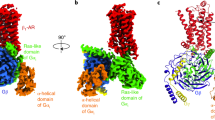Abstract
SIGNIFICANT progress has recently been made toward defining and understanding the molecular basis of hormone sensitivity in the β-adrenoreceptor-adenylate cyclase system. Through the use of biochemical1,2 and genetic3,4 techniques it has become apparent that this system is comprised of at least three separate components: the β-adrenoreceptor, which is responsible for the binding of β-adrenergic agents; the catalytic unit of the enzyme adenylate cyclase, responsible for the conversion of ATP to cyclic AMP; and a nucleotide regulatory component or components which seems to possess a GTPase activity5 and to be required for coupling of the β-adrenoreceptor to the adenylate cyclase enzyme6. As has been demonstrated by Orly and Schramm7 and confirmed by Schwarzmeier and Oilman8 in cell fusion experiments, these components interact to produce the hormone-responsive adenylate cyclase system and this interaction occurs even when the separate functions are donated by heterologous cell types. Frog and turkey erythrocytes each possess a catecholamine-responsive adenylate cyclase. Although similar in some respects these two well-studied systems differ markedly with respect to their drug affinities and intrinsic activities. Intrinsic activity is defined as the maximal ability of a drug to stimulate a biological or biochemical response. To elucidate the role of the β-adrenoreceptor in the expression of these properties, we report here the use of cell fusion techniques to construct a hybrid which possesses the β-adrenoreceptor of the turkey erythrocyte and the adenylate cyclase of the frog erythrocyte. The characteristics of this hybrid indicate that although the receptor determines relative drug affinities (for example, β1 compared with β2 subtypes of receptor), it is a component distal to the receptor which determines relative drug intrinsic activities.
This is a preview of subscription content, access via your institution
Access options
Subscribe to this journal
Receive 51 print issues and online access
$199.00 per year
only $3.90 per issue
Buy this article
- Purchase on Springer Link
- Instant access to full article PDF
Prices may be subject to local taxes which are calculated during checkout
Similar content being viewed by others
References
Limbird, L. E. & Lefkowitz, R. J. J. biol. Chem. 252, 799–802 (1977).
Haga, T., Haga, K. & Gilman, A. G. J. biol. Chem. 252, 5776–5782 (1977).
Insel, P. A. et al. Molec. Pharmac. 12, 1062–1069 (1976).
Ross, E. M. & Gilman, A. G. Proc. natn. Acad. Sci. U.S.A. 74, 3715–3719 (1977).
Cassel, D. & Selinger, Z. Proc. natn. Acad. Sci. U.S.A. 74, 3307–3311 (1977).
Haga, T., Ross, E. M., Anderson, H. J. & Gilman, A. G. Proc. natn. Acad. Sci. U.S.A. 74, 2016–2020 (1977).
Orly, J. & Schramm, M. Proc. natn. Acad. Sci. U.S.A. 73, 4410–4414 (1976).
Schwarzmeier, J. D. & Gilman, A. G. J. Cyclic Nucleotide Res. 3, 227–238 (1977).
Pike, L. J. & Lefkowitz, R. J. J. Cyclic Nucleotide Res. 4, 27–34 (1978).
Watkins, J. F. Meth. Virol. 5, 1–32 (1971).
Mickey, J. V., Tate, R., Mullikin, D. & Lefkowitz, R. J. Molec. Pharmac. 12, 409–419 (1976).
Lefkowitz, R. J. J. biol. Chem. 249, 6119–6124 (1974).
Salomon, Y., Londos, C. & Rodbell, M. Analyt. Biochem. 58, 541–548 (1974).
Cassel, D. & Selinger, Z. Biochem. biophys. Res. Commun. 77, 868–873 (1977).
Brown, E. M., Fedak, S. A., Woodard, C. J., Aurbach, G. D. & Rodbard, D. J. biol. Chem. 251, 1239–1246 (1976).
Mukherjee, C., Caron, M. G., Mullikin, D. & Lefkowitz, R. J. Molec. Pharmac. 12, 16–31 (1976).
Lands, A. M., Arnold, A., McAuliff, J. P., Luduena, F. P. & Brown, T. C. Nature 214, 597–598 (1967).
Lefkowitz, R. J. & Williams, L. T. Proc. natn. Acad. Sci. U.S.A. 74, 515–519 (1977).
Schramm, M., Orly, J., Eimerl, S. & Korner, M. Nature 268, 310–313 (1977).
Author information
Authors and Affiliations
Rights and permissions
About this article
Cite this article
PIKE, L., LIMBIRD, L. & LEFKOWITZ, R. β-Adrenoreceptors determine affinity but not intrinsic activity of adenylate cyclase stimulants. Nature 280, 502–504 (1979). https://doi.org/10.1038/280502a0
Received:
Accepted:
Published:
Issue Date:
DOI: https://doi.org/10.1038/280502a0
This article is cited by
Comments
By submitting a comment you agree to abide by our Terms and Community Guidelines. If you find something abusive or that does not comply with our terms or guidelines please flag it as inappropriate.



